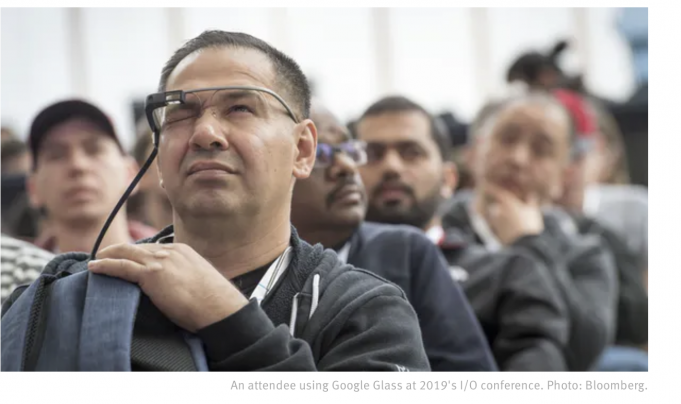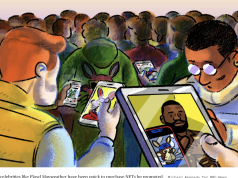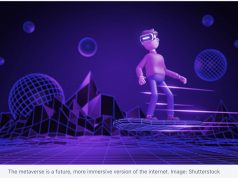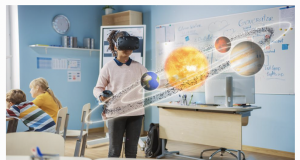The Information, May 10th, 2022 Ray Olson
Google is set to hold its annual I/O developer conference tomorrow, which makes now as good a time as any to check in on how Alphabet is faring when it comes to AR and VR.
While much of the product buzz ahead of this year’s conference concerns the potential reveal of a Pixel-branded watch, we’re expecting to receive some updates about Google’s ongoing efforts on immersive software and hardware. Will we see anything to rival the metaverse bonanza that preceded Facebook’s rebranding last fall? Probably not, but given last year’s surprise reveal of Project Starline and recent hiring and acquisition moves from Google, here are a few AR/VR topics to watch for, in order from most to least likely:
- Google will give an update on the state of ARCore, its mobile AR software development kit. This one is a lock: I/O will upload an on-demand sessionregarding ARCore featuring AR product manager Eric Lai and engineering manager Jason Finder after the initial livestreamed keynotes finish airing. This may only amount to an overview of some minor improvements, but last year’s event debuted ARCore’s Raw Depth API, which allows for more accurate placements of AR content in the real world.
- Expect some news regarding AR and navigation as well. The aforementioned session on ARCore is also tagged for developers interested in maps and location software. So perhaps we’ll see improvements to the Live Maps outdoor AR navigation feature or to the availability of indoor AR directions that Google began rolling out in urban malls, airports and transit stations last year.
- Another look at Starline is possible. When Google unveiled its sophisticated teleconferencing booths at last year’s I/O, the company noted that they were already being used internally and that it was “planning trial deployments with enterprise partners” for later in 2021. Google may not be ready to talk about any broader plans to sell Starline just yet, but if Google has managed to streamline the prototype booths (as detailed in a paper last December) for those early enterprise trials, that could be worth an update.
- Don’t bet on a big reveal of Project Iris just yet. Google’s Iris team is reportedly working on a mixed reality headset targeted for 2024 and could be setting the former North team to work on a new pair of AR glasses. Remember, though, this is Google we’re talking about. Project Starline is a different enough concept that shows well in a video demonstration. But glasses products like the North Focals and Meta’s Ray-Bans have continued to draw so-so comparisons with Google Glass. For that reason, it’d be a surprise to see the company detail its plans for new glasses or a headset until it’s ready to have press and analysts try them and see first-hand any lessons Google has learned in the time since Glass disappointed and Daydream flopped. Since I/O will again be a limited-attendance event this year, anything beyond the kind of early-look treatment Starline got in 2021 would be unlikely.
A Growing List of Possible Apple Headset Hurdles
Almost exactly a month from now, it’ll be Apple’s turn for a crack at its annual developer’s conference, and I’m personally expecting much of the same. As Bloomberg’s Mark Gurman has reported, delays on Apple’s mixed reality headset have likely pushed its full reveal past the early June date of WWDC 2022. News on Apple’s AR RealityKit software and, possibly, its ties to a new AR-focused operating system could instead end up serving as a preview of things to come on the hardware side.
If you’re a bit of a natural pessimist like me, though, a number of reports over the past few days could be taken as signs that June’s event could be quite quiet on the headset front. Continued disruptions on the manufacturing side of the business make a delayed reveal and release seem all but certain.
Yesterday, The Wall Street Journal published a report detailing how ongoing pandemic restrictions on travel meant that China-based engineers are taking on increasing amounts of responsibility at Apple, a change in the company’s normal operations that could easily have an outsized effect on new products. While local engineers and those at manufacturers like Foxconn have had years to accumulate expertise when it comes to Apple’s established devices like the iPhones, having to solve new headset-specific engineering issues while also navigating these shifts in communication and decision-making between Cupertino and China can’t be easy.
Then there’s the return of lockdown measures at Apple-contracted factories, something which the company has already warned could reduce device revenues in the billions in the June quarter. Reuters reported that Quanta, a major assembler of MacBooks for Apple, has experienced numerous positive Covid cases at a closed-loop factory site in Shanghai despite only being at a fraction of its full employee capacity.
The longer these disruptions continue, the decisions Apple may have to make won’t get any easier. If there’s any significant overlap in terms of the components or manufacturing know-how needed to make the headsets and existing, already-successful product lines, don’t be shocked if Apple prioritizes what it already knows will sell. That means iPhones, iPads or MacBooks rather than a mixed reality headset.
Other news:
- In somewhat-related Apple manufacturing news, the company is ceasing production of the iPod Touch. Gadget aficionados may be lamenting the end of an era for dedicated music players, but remember that Apple pitched mobile ARand FaceTime as bigger draws for the device in 2019.
- Advertising giant WPP has partnered with Epic Games on a program designed to “upskill thousands” at WPP on making branded content in Fortnite and on 3D and virtual production techniques that leverage Epic’s Unreal Engine.
- A new survey of consumer behavior conducted by AR creation platform Camera IQ found that 29% of media agencies polled were already buying AR ads, compared to 67% that hoped to use AR in campaigns in the future.
- San Jose-based semiconductor company Spectra7 says that its VR-specific chipset has been chosen by “a global tier-one game platform maker” for an unidentified second-generation headset.









